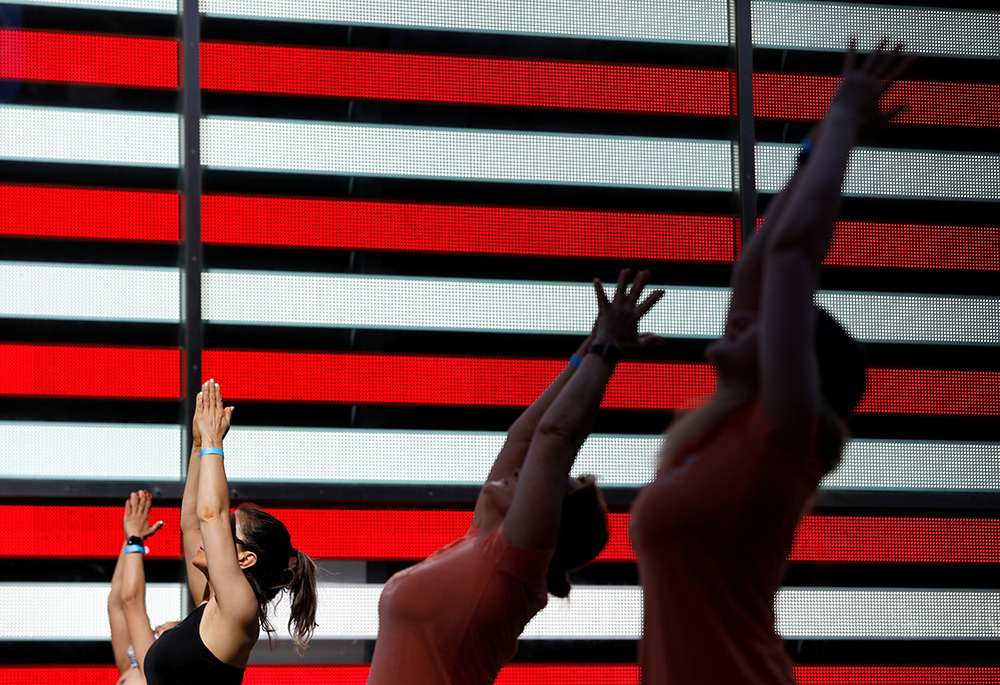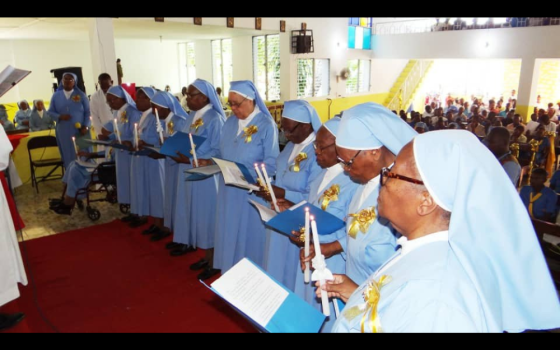
People in New York City perform yoga to celebrate the summer solstice June 20, 2021. (CNS/Reuters/Andrew Kelly)
In the darkness of the isolation at the beginning of Covid, not being able to participate in in-person worship services wounded me. I ached for Christ and for community. I felt distanced from Christ's body — and, more surprisingly, also from my own.
As Catholics, we are a Eucharist-centered people: Our faith hinges on the body of our God. But we have too few resources regarding the relationship between the body and spirituality, and I felt the lack deeply. Grace came to me in an unexpected way when I turned to YouTube for solace, stumbling upon yoga videos aimed to heal restlessness. In my search for peace in the midst of the pandemic anxiety, I found healing and exploration through the practice of yoga — a practice that ultimately brought me closer to Christ and the church.
What is yoga, anyway? Yoga is a practice. Just as Pope Benedict XVI calls the church to continual conversion, yoga challenges one to enter each day with a posture of responsiveness, rather than a posture of reactivity. It is rhythm and mindfulness; it is breath linked to movement. Yoga suggests that the quality of breath reflects the quality of mind. In learning to stabilize our breath, we gain the agency and power to stabilize our minds, and thus our bodies.
Christianity might have a controversial relationship with yoga, but yoga has also long had a contentious relationship with the West. I am grateful for my yoga practice and how it has brought me closer to Christ, but I am also aware of the westernization of yoga from which I benefit, as well as the danger of cultural appropriation that comes with this privilege.
Different eras of yoga have formed throughout time and location. During the Classical Period, Pantajali, a Hindu mystic, developed the Eight Limbs of Yoga, generating a philosophy that related breath to movement. There are similarities between the Eight Limbs of Yoga and the Ten Commandments, but maybe most particularly in the first two: the Yamas and Niyamas, the "Do's and Don'ts" of a yoga practice.

A yoga class is seen outside a home along Maryland's Chesapeake Bay July 1, 2021. (CNS/Bob Roller)
The first Yama is ahimsa, which means nonviolence. This serves as the main pillar of all of yoga; all other Yamas and Niyamas stem and flow from this concept of nonviolence. In her book The Yamas & Niyamas: Exploring Yoga’s Ethical Practice, author Deborah Adele says that "nonviolence is a stance of right relationship with others and with self that is neither self-sacrifice nor self-aggrandizement. This tenet guides us to live together." There is a liberation that is granted through the centering of nonviolence, but it is a liberation that requires a co-responsibility of taking care of each other. As St. Mother Teresa states, "if we have no peace, it is because we have forgotten that we belong to each other." The concept of ahimsa through the practice of yoga reminds us that we belong to one another.
The second Yama is satya, which means truthfulness. Adele notes that nonviolence and truthfulness are paired together in yoga as the two main guidelines of the philosophy, holding each other accountable by offering a nonviolent methodology in actualizing truthfulness. Too often in Christian circles, we focus only on truth — even allowing violence, physical or otherwise, as a means to this end. Yoga has challenged me to think more pastorally in how to reveal these truths to others, as well as to myself.
Advertisement
In the Rev. Dr. Martin Luther King Jr.'s "Pilgrimage to Nonviolence," he states that "the choice today is no longer between violence and nonviolence. It is either nonviolence or nonexistence." There is a lot at stake here in committing to a posture of peace, for King suggests that it is either peace or nonbeing. The practice of yoga invites a commitment to a culture of peace, and thus a culture of being.
In further illustration of the power of yoga's practice of nonviolence, it's worth noting that yoga is one of the top recommended healing practices that therapists offer their clients, specifically clients of sexual abuse. For victims of any trauma, yoga serves as a way for folks to reclaim their body and their agency. It creates an environment and safe space that maximizes opportunity for self-care, and thus the potentiality of healing.
In the savasana pose, also known as "corpse pose," you lay on your back — legs extended long, arms by your side — and just breathe. It is here in savasana where I have found that Christ meets me, over and over again, and where I meet Christ; it is here where my prayer thrives. This encounter with Christ through yoga does not replace the Eucharist for me, but rather forms me to hunger for the receiving of it even more.
'Yoga granted me agency, and thus liberation, to recognize how present Christ is in the world, within me and beyond.'
One of my dear friends from divinity school, Kayal, says that "as Christians, we are able to see the world as it ought to be, but the world is not what it should be." Yoga creates a space for me to tap into my mind and body to take on this quest as a Christian to see the world as it ought to be. I leave each yoga class as a better Christian — with a sense of sustainable hope.
Yoga has helped me to fall out of love with how my body looks, and rather to fall in love with how my body moves and feels. It has helped me to realize how the Spirit dwells within me, and to focus less on how I appear and more so on how I feel with the Spirit. I have learned to honor how my body moves through the Earth in an aspiring Christ-like manner, searching for wholeness in finding relation to one another through Christ.
Being Catholic calls for our Catholicity to shine through in what may be deemed as non-Catholic settings. It is to act as an extension of the Incarnation in what may be deemed by some as unholy. It is to find a sustainable Christian hope in all we do. Yoga granted me agency, and thus liberation, to recognize how present Christ is in the world, within me and beyond, strengthening my desire for the Eucharist, but also finding Christ present and active outside of the Mass, too.





